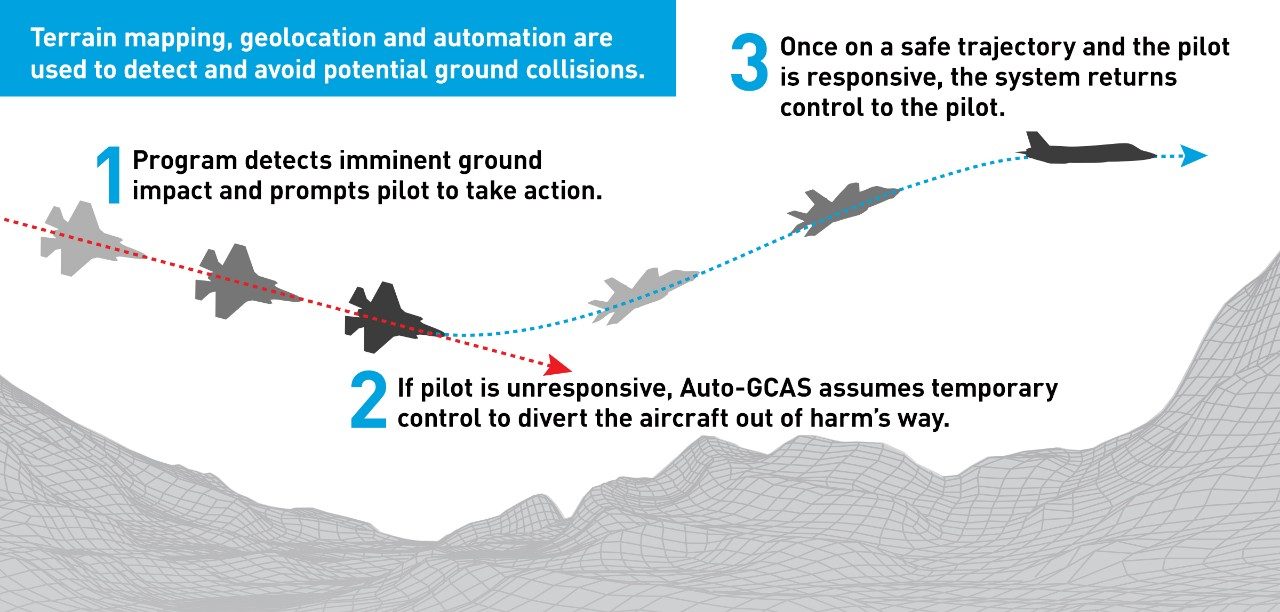Saving the Good Guys with Auto GCAS Technology
The cockpit of a fighter jet is a busy and dangerous place to work. High-speed fighter aircraft maneuvers can produce g-forces strong enough to render a pilot unconscious or cause spatial disorientation. The pace and complexity of modern aerial combat can also mentally “overload” a pilot and lead to task saturation or target fixation. All can prove deadly.
Thankfully, innovative systems have been developed to reduce these risks and help eliminate the leading cause of F-16 pilot fatalities: crashing an undamaged aircraft into the ground. The Automatic Ground Collision Avoidance System (Auto GCAS) was purpose-built to prevent these deadly crashes and has already been credited with 12 saves—13 pilots, 12 F-16s—since the system entered service with the U.S. Air Force in late 2014.
12 Saves and Counting
This video from the head-up-display (HUD) of an F-16 illustrates how the Auto GCAS helped save the life of an F-16 student pilot who lost consciousness during a training mission.
The student pilot, training with the Arizona Air National Guard’s 152nd Fighter Squadron, succumb to G-Induced Loss of Consciousness (GLOC) during a high-speed maneuver. As the unconscious pilot’s F-16 careened toward the ground, the Auto GCAS determined that a ground collision was imminent and initiated a fly up maneuver to roll the F-16’s wings level and upright as the pilot regained consciousness and added Gs to the recovery, saving both pilot and plane.
What is Auto GCAS?
The Auto GCAS, developed jointly by Lockheed Martin Skunk Works®, the Air Force Research Laboratory and the National Aeronautics and Space Administration (NASA), is designed to reduce incidents of what is known as controlled flight into terrain, or CFIT. According to U.S. Air Force statistics, CFIT incidents account for 26 percent of aircraft losses and a staggering 75 percent of all F-16 pilot fatalities.
According to Ed Griffin, Lockheed Martin Skunk Works’ program manager for the Automatic Collision Avoidance Technologies (ACAT) Fighter Risk Reduction Program, the system consists of a set of complex collision avoidance and autonomous decision making algorithms that utilize precise navigation, aircraft performance and on-board digital terrain data to determine if a ground collision is imminent. If the system predicts an imminent collision, an autonomous avoidance maneuver—a roll to wings-level and +5g pull—is commanded at the last instance to prevent ground impact.
The Auto GCAS executes in the background and automatically provides protection whether the pilot is distracted, task-saturated, incapacitated, or unconscious. No action is required by the pilot, though the system does have a pilot override function.
“Based on the data we’ve seen so far, the Auto GCAS is doing exactly what it was designed to do: save priceless lives and valuable military aircraft,” said Griffin. “Many aviation professionals believe autonomy is emerging as the new frontier in aviation and Auto GCAS currently represents the leading edge of autonomy as it applies to manned platforms.”

Saving Tomorrow's Pilots
The Auto GCAS capability is currently operating on more than 600 U.S. Air Force F-16 Block 40/50 aircraft worldwide. Auto GCAS flight testing was also recently completed on U.S. Air National Guard F-16 Block 30 aircraft and the capability is expected to be fielded on that fleet in 2020. Lockheed Martin and the F-35 Joint Program Office (JPO) completed F-35 Auto GCAS integration and flight testing in 2018 and plan to begin fielding this proven life-saving technology in June 2019. The Auto GCAS will ultimately protect more than 3,200 F-35s and their pilots worldwide. The F-35 Joint Program Office estimates the Auto GCAS will prevent more than 26 ground collisions during the service of the F-35 fleet.
In addition to the Auto GCAS, Lockheed Martin and the U.S. Government have also developed an Automatic Air Collision Avoidance System (Auto ACAS). As its name suggest, Auto ACAS is designed to avoid air-to-air collisions. Together, the two systems form the Automatic Integrated Collision Avoidance System (Auto ICAS), the world’s first fully automatic integrated combat flight safety system designed to prevent both air-to-air and air-to-ground collisions.
In recognition of the Auto ACAS and Auto ICAS programs, Lockheed Martin and the AFRL received Aviation Week Laureate Awards in 2016 and 2019 for the development and flight testing of these systems, which predict collisions and automatically maneuver fighter aircraft to avoid ground collisions and mid-air crashes in training exercises. These systems are projected to save 34 aircraft, 25 pilot lives and $2.3 billion over the next 15 years.
The National Aeronautic Association recognized the significance of the Auto GCAS by awarding the 2018 Robert J. Collier Trophy to the joint team that developed it.
As Col. Chris Baird, former U.S. Air Force F-16 System Program Manager, put it, “It’s not just about killing the bad guys with airpower. It’s also equally about saving the good guys.”
A Close Collaboration
All of this success did not come overnight. Auto GCAS is the result of research collected by Lockheed Martin’s Skunk Works®, AFRL and NASA spanning nearly three decades. An Air Force F-16D was ultimately selected as a test platform for the system and related flight-testing began in 2009 at the NASA Armstrong Flight Research Center (AFRC) located at Edwards Air Force Base, California.
Lockheed Martin worked closely with its U.S. Government and Air Force customers to refine this game-changing Auto GCAS capability and help deliver it to the warfighter. Auto GCAS has already saved numerous pilots and will save many more in the future as the system is implemented more broadly across the global F-16 fleet and applied to other aircraft platforms.



